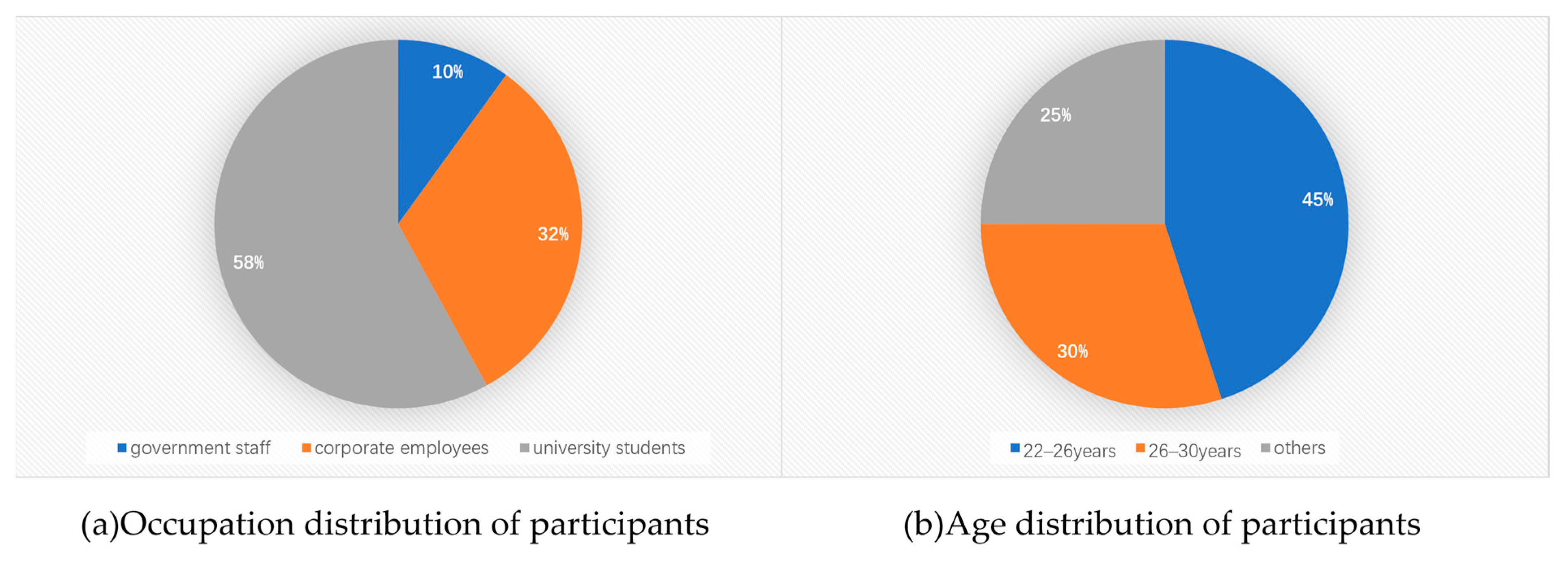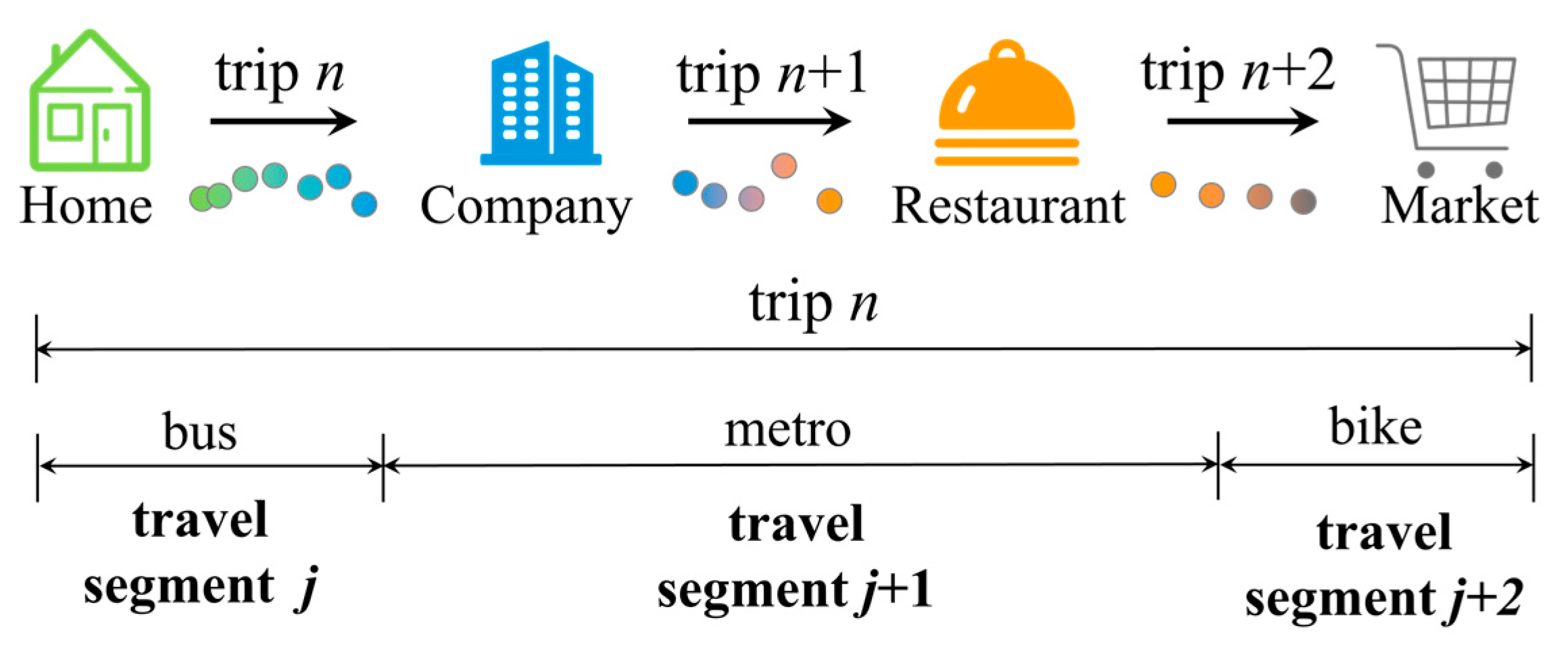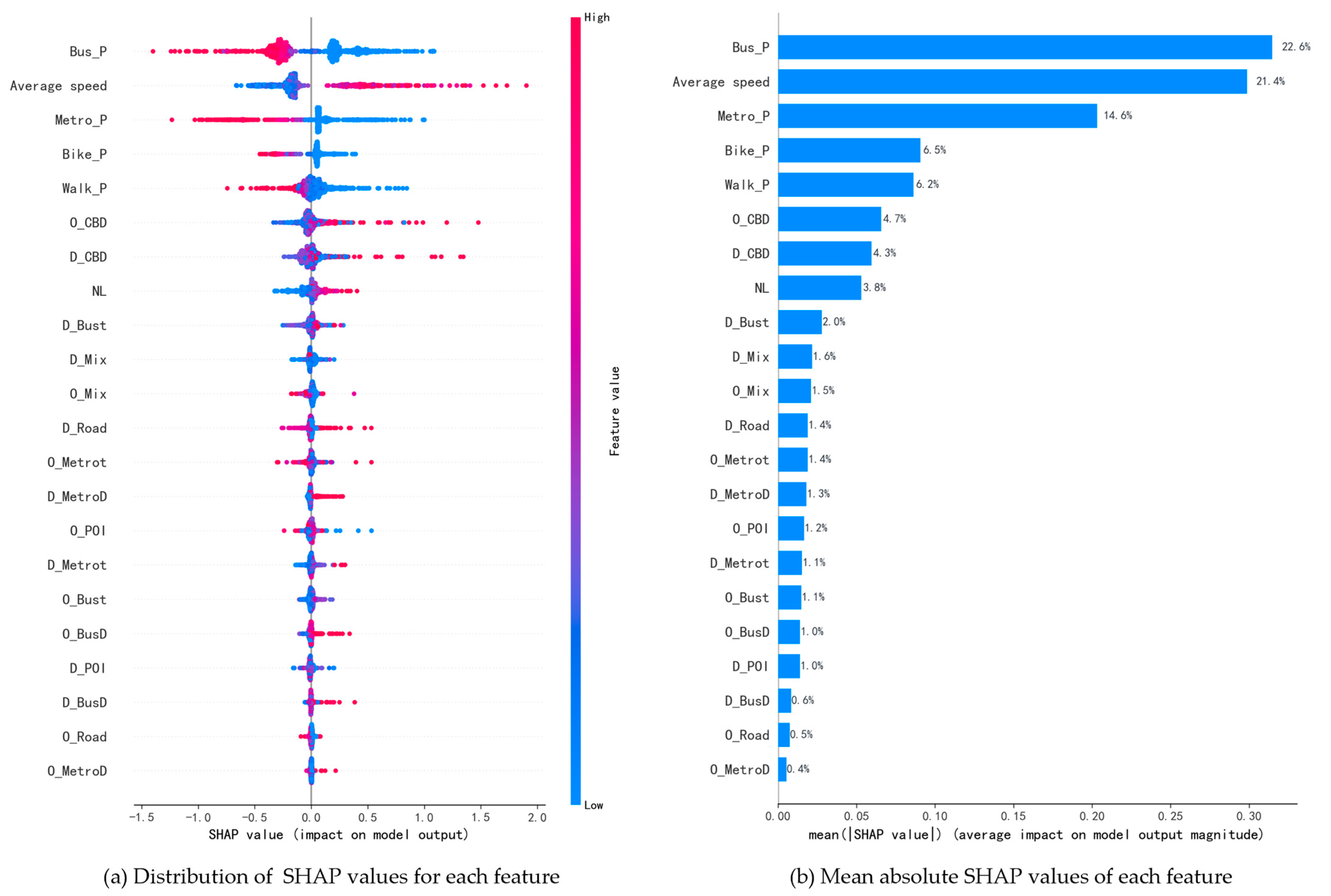What Determines Carbon Emissions of Multimodal Travel? Insights from Interpretable Machine Learning on Mobility Trajectory Data
Abstract
1. Introduction
- It utilizes real-world, continuous trajectory data to integrate multimodal travel behavior and develops a carbon emission calculation method tailored to the carbon footprint of multimodal mobility.
- It applies interpretable machine learning techniques to identify key transportation behaviors and built environment factors that influence individual-level carbon emissions from multimodal travel, providing insights into the mechanisms behind low-carbon mobility decisions.
2. Literature Review
2.1. Estimation of Travel Carbon Emissions
2.2. Determinants of Travel Carbon Emissions
3. Data Preparation
3.1. Data Source and Description
3.2. Description of Individual Travel Data
- The trip dataset includes metadata such as user ID, trip ID, trip start and end times, origin and destination coordinates, and transportation mode labels. These labels were manually annotated by participants based on their actual travel modes. Modes include walking, biking, bus, metro, and private car.
- The GPS trajectory dataset records detailed spatial–temporal information for each trip, including timestamp, longitude, latitude, and instantaneous speed. Most data points were recorded at intervals of 1–5 s or 5–10 m, providing high-resolution tracking that is well-suited for identifying mode transitions and segmenting travel patterns.
3.3. Data Extraction for Multimodal Travel
4. Methodology
4.1. Travel Carbon Emission Estimation
4.1.1. Motor Vehicle Emission Model
4.1.2. Metro Emission Model
4.1.3. Carbon Emission Calculation of Multimodal Travel
4.2. Interpretable Machine Learning for Multimodal Travel
4.2.1. Selection of Characteristic Variables
- Average speed of the multimodal travel. This is calculated as the total travel distance covered by bus, metro, taxi, car, bike, and walking within a multimodal travel divided by the total travel time.
- Non-linearity coefficient. This metric is defined as the ratio of the actual path length to the straight-line distance between the origin and destination. A higher value indicates a more circuitous route, generally implying a longer travel time and reduced efficiency, which may result in higher CO2 emissions.
- Modal share by distance. The proportions of distance traveled by bus, metro, bike, and walking within a given multimodal travel segment are calculated to reflect the composition of low-carbon modes.
4.2.2. Interpretable Machine Learning Models
4.2.3. Model Interpretation Methods
5. Results and Discussion
5.1. Model Performance and Selection
5.2. Feature Importance and Impact Analysis
6. Conclusions and Implications
- Among interpretable machine learning models, XGBoost achieved the highest accuracy for predicting CO2 emissions from multimodal travel.
- All explanatory variables collectively contributed to the prediction of CO2 emissions, with transportation-related variables accounting for 75.1% of the model’s explanatory power and built environment factors contributing the remaining 24.9%.
- The analysis indicates that bus usage, average speed, and metro usage are the top three contributors to carbon emissions, followed by cycling, walking, destination distance to the CBD, and non-linear travel route.
- The PDP analysis reveals that substantial emission reductions are observed only when the modal shares of bus, metro, and cycling exceed approximately 40%, 40%, and 30%, respectively. This indicates the existence of threshold effects, where merely modest increases in sustainable mode shares may not yield significant carbon benefits unless these thresholds are surpassed.
- In addition, travel-related carbon emissions are generally lower when the spatial distance between trip origins and destinations falls within the range of 10 to 11 km from the central business district (CBD). This suggests that mid-range trips at this distance are associated with greater use of public transit and non-motorized modes, thereby contributing to more efficient and carbon-efficient travel. These findings are consistent with global research—for instance, Ewing and Cervero [26] found that mid-range commutes in U.S. cities are more likely to involve active transportation, while Akuh et al. [10,11,12] demonstrated that balanced land use in European new towns reduces reliance on high-emission travel modes. Together, these parallels suggest the broader applicability of our analytical framework for sustainable urban transport planning.
7. Limitations and Future Directions
Author Contributions
Funding
Institutional Review Board Statement
Informed Consent Statement
Data Availability Statement
Conflicts of Interest
References
- Chen, S.; Long, H.; Chen, B.; Feng, K.; Hubacek, K. Urban Carbon Footprints across Scale: Important Considerations for Choosing System Boundaries. Appl. Energy 2020, 259, 114201. [Google Scholar] [CrossRef]
- Zhang, Z.; Yu, X.; Hou, Y.; Chen, T.; Lu, Y.; Sun, H. Carbon Emission Patterns and Carbon Balance Zoning in Urban Territorial Spaces Based on Multisource Data: A Case Study of Suzhou City, China. IJGI 2023, 12, 385. [Google Scholar] [CrossRef]
- Zhu, Z.; Lu, C. Life Cycle Assessment of Shared Electric Bicycle on Greenhouse Gas Emissions in China. Sci. Total Environ. 2023, 860, 160546. [Google Scholar] [CrossRef]
- Zou, Y.; Xiao, G.; Li, Q.; Biancardo, S.A. Intelligent Maritime Shipping: A Bibliometric Analysis of Internet Technologies and Automated Port Infrastructure Applications. J. Mar. Sci. Eng. 2025, 13, 979. [Google Scholar] [CrossRef]
- Li, W.; Bao, L.; Li, Y.; Si, H.; Li, Y. Assessing the Transition to Low-Carbon Urban Transport: A Global Comparison. Resour. Conserv. Recycl. 2022, 180, 106179. [Google Scholar] [CrossRef]
- Li, W.; Bao, L.; Wang, L.; Li, Y.; Mai, X. Comparative Evaluation of Global Low-Carbon Urban Transport. Technol. Forecast. Soc. Change 2019, 143, 14–26. [Google Scholar] [CrossRef]
- Li, J.; Jiang, C.; Han, K.; Yu, Q.; Zhang, H. High-Resolution Spatiotemporal Inference of Urban Road Traffic Emissions Using Taxi GPS and Multi-Source Urban Features Data: A Case Study in Chengdu, China. Urban Inform. 2024, 3, 17. [Google Scholar] [CrossRef]
- Li, W.; Pu, Z.; Li, Y.; Tu, M. How Does Ridesplitting Reduce Emissions from Ridesourcing? A Spatiotemporal Analysis in Chengdu, China. Transp. Res. Part D Transp. Environ. 2021, 95, 102885. [Google Scholar] [CrossRef]
- Ren, L.; Guo, X.; Wu, J.; Singh, A.K. Data Mining and Spatio-Temporal Characteristics of Urban Road Traffic Emissions: A Case Study in Shijiazhuang, China. PLoS ONE 2023, 18, e0295664. [Google Scholar] [CrossRef] [PubMed]
- Herbruggen, B.V.; Logghe, S. Tremove version 2.3 simulation model for european environmental transport policy analysis. In Proceedings of the 14th International Symposium “Transport and Air Pollution”, Graz, Germany, 1–3 June 2005. [Google Scholar]
- Schade, B.; Wiesenthal, T. Developments in Energy Use for Transport in 27 European Union Countries through 2030: Outcome of iTREN-2030 Project. Transp. Res. Rec. 2011, 2252, 31–39. [Google Scholar] [CrossRef]
- Akuh, R.; Zhong, M.; Raza, A.; Dong, Y. A Method for Evaluating the Balance of Land Use and Multimodal Transport System of New Towns/Cities Using an Integrated Modeling Framework. Multimodal Transp. 2023, 2, 100063. [Google Scholar] [CrossRef]
- Cheng, B.; Li, J.; Su, H.; Lu, K.; Chen, H.; Huang, J. Life Cycle Assessment of Greenhouse Gas Emission Reduction through Bike-Sharing for Sustainable Cities. Sustain. Energy Technol. Assess. 2022, 53, 102789. [Google Scholar] [CrossRef]
- Zhao, J.; Yuan, C.; Mao, X.; Ma, N.; Duan, Y.; Zhu, J.; Wang, H.; Tian, B. Identifying the Nonlinear Impacts of Road Network Topology and Built Environment on the Potential Greenhouse Gas Emission Reduction of Dockless Bike-Sharing Trips: A Case Study of Shenzhen, China. IJGI 2024, 13, 287. [Google Scholar] [CrossRef]
- Shi, W.; Xiang, Y.; Ying, Y.; Jiao, Y.; Zhao, R.; Qiu, W. Predicting Neighborhood-Level Residential Carbon Emissions from Street View Images Using Computer Vision and Machine Learning. Remote Sens. 2024, 16, 1312. [Google Scholar] [CrossRef]
- Liu, J.; Han, K.; Chen, X.; Ong, G.P. Spatial-Temporal Inference of Urban Traffic Emissions Based on Taxi Trajectories and Multi-Source Urban Data. Transp. Res. Part C Emerg. Technol. 2019, 106, 145–165. [Google Scholar] [CrossRef]
- Handy, S.; Cao, X.; Mokhtarian, P.L. Self-Selection in the Relationship between the Built Environment and Walking: Empirical Evidence from Northern California. J. Am. Plan. Assoc. 2006, 72, 55–74. [Google Scholar] [CrossRef]
- Yu, W.; Xia, L.; Cao, Q. A Machine Learning Algorithm to Explore the Drivers of Carbon Emissions in Chinese Cities. Sci. Rep. 2024, 14, 23609. [Google Scholar] [CrossRef]
- Zeng, J.; Liu, Y.; Ding, J.; Yuan, J.; Li, Y. Estimating On-Road Transportation Carbon Emissions from Open Data of Road Network and Origin-Destination Flow Data V1. arXiv 2024, arXiv:2402.05153. [Google Scholar] [CrossRef]
- Pu, Y.; Yang, C.; Liu, H.; Chen, Z.; Chen, A. Impact of License Plate Restriction Policy on Emission Reduction in Hangzhou Using a Bottom-up Approach. Transp. Res. Part D Transp. Environ. 2015, 34, 281–292. [Google Scholar] [CrossRef]
- Ibarra-Espinosa, S.; Ynoue, R.; O’Sullivan, S.; Pebesma, E.; Andrade, M.d.F.; Osses, M. VEIN v0.2.2: An R Package for Bottom–up Vehicular Emissions Inventories. Geosci. Model Dev. 2018, 11, 2209–2229. [Google Scholar] [CrossRef]
- Sun, D.; Zhang, K.; Shen, S. Analyzing Spatiotemporal Traffic Line Source Emissions Based on Massive Didi Online Car-Hailing Service Data. Transp. Res. Part D Transp. Environ. 2018, 62, 699–714. [Google Scholar] [CrossRef]
- Luo, X.; Dong, L.; Dou, Y.; Zhang, N.; Ren, J.; Li, Y.; Sun, L.; Yao, S. Analysis on Spatial-Temporal Features of Taxis’ Emissions from Big Data Informed Travel Patterns: A Case of Shanghai, China. J. Clean. Prod. 2017, 142, 926–935. [Google Scholar] [CrossRef]
- Li, W.; Wang, L.; Pu, Z.; Cheng, L.; Yang, L. What Determines the Real-World CO2 Emission Reductions of Ridesplitting Trips? Travel Behav. Soc. 2024, 35, 100734. [Google Scholar] [CrossRef]
- Ntziachristos, L.; Samaras, Z. Methodology for the calculation of exhaust emissions. In EMEP/EEA Emission Inventory Guidebook; SNAPs 070100-070500, NFRs 1A3bi-iv; European Environment Agency: Copenhagen, Denmark, 2024. [Google Scholar]
- Ewing, R.; Cervero, R. Travel and the Built Environment. J. Am. Plan. Assoc. 2010, 76, 265–294. [Google Scholar] [CrossRef]
- Friedman, J.H. Greedy Function Approximation: A Gradient Boosting Machine. Ann. Statist. 2001, 29, 1189–1232. [Google Scholar] [CrossRef]
- Prokhorenkova, L.; Gusev, G.; Vorobev, A.; Dorogush, A.V.; Gulin, A. CatBoost: Unbiased Boosting with Categorical Features V5. arXiv 2017, arXiv:1706.09516. [Google Scholar] [CrossRef]
- Ke, G.; Meng, Q.; Finley, T.; Wang, T.; Chen, W.; Ma, W.; Ye, Q.; Liu, T.-Y. LightGBM: A Highly Efficient Gradient Boosting Decision Tree. In Proceedings of the 31st International Conference on Neural Information Processing Systems, Long Beach, CA, USA, 4–9 December 2017; pp. 3149–3157. [Google Scholar]
- Chen, T.; Guestrin, C. XGBoost: A Scalable Tree Boosting System. In Proceedings of the Proceedings of the 22nd ACM SIGKDD International Conference on Knowledge Discovery and Data Mining, San Francisco, CA, USA, 13–17 August 2016; Association for Computing Machinery: New York, NY, USA; pp. 785–794. [Google Scholar]
- Lundberg, S.M.; Erion, G.G.; Lee, S.-I. Consistent Individualized Feature Attribution for Tree Ensembles V3. arXiv 2018, arXiv:1802.03888. [Google Scholar] [CrossRef]




| Field Name | Data Type | Example | Description |
|---|---|---|---|
| UserID | String | uxd7kLmn9pq2stv8wxy3zj | User identifier |
| TripID | String | ord5m8n2kxp7qrv4t9hwyc | Trip order ID |
| Start_Time | Datetime | 15 June 2023 08:22:35 | Start time of the trip |
| Start_Time | Datetime | 15 June 2023 08:59:10 | End time of the trip |
| Start_Location | geo_point | [113.256, 23.134] | Coordinates of origin |
| End_Location | geo_point | [113.389, 23.098] | Coordinates of destination |
| Type | String | bus | Mode of transport |
| Field Name | Data Type | Example | Description |
|---|---|---|---|
| OrderID | String | uxd7kLmn9pq2stv8wxy3zj | User identifier |
| TripID | String | ord5m8n2kxp7qrv4t9hwyc | Trip order ID |
| Timestamp | Datetime | 15 June 2023 08:25:42 | Timestamp |
| Longitude | Float | 113.267892 | Longitude |
| Latitude | Float | 23.128456 | Latitude |
| Speed | Float | 4.2524 | Instantaneous speed (m/s) |
| Parameters | Car (Euro III) | Bus (Euro III) |
|---|---|---|
| 1.248 × 10−4 | −2.410 × 10−4 | |
| 3.278 × 10−3 | 3.382 × 10−2 | |
| 2.807 × 100 | 2.443 × 100 | |
| 3.200 × 10−9 | 4.659 × 100 | |
| −1.244 × 10−4 | −5.050 × 10−5 | |
| 2.836 × 10−2 | 8.521 × 10−3 | |
| 2.954 × 10−2 | 6.128 × 10−2 |
| Feature Name | Descriptions | Unit | |
|---|---|---|---|
| Travel features | Average speed | The average speed of travel | km/h |
| Bus_P | The proportion of the bus travel distance in the total distance of the multimodal travel | / | |
| Metro_P | The proportion of metro travel distance in the total distance of the multimodal travel | / | |
| Bike_P | The proportion of bike travel distance in the total distance of the multimodal travel | / | |
| Walk_P | The proportion of walking travel distance in the total distance of the multimodal travel | / | |
| NL | Non-linearity coefficient of multimodal travel | / |
| Feature Name | Descriptions | Unit | ||
|---|---|---|---|---|
| “5D” Built environment features | Density | O_POI | POI density in the origin buffer zone | quantity/km2 |
| D_POI | POI density in the destination buffer zone | quantity/km2 | ||
| O_MetroD | Metro station density in the origin buffer zone | quantity/km2 | ||
| D_MetroD | Metro station density in the destination buffer zone | quantity/km2 | ||
| O_BusD | Bus station density in the origin buffer zone | quantity/km2 | ||
| D_BusD | Bus station density in the destination buffer zone | quantity/km2 | ||
| Diversity | O_Mix | Land use mix degree in the origin buffer zone | / | |
| D_Mix | Land use mix degree in the destination buffer zone | / | ||
| Destination accessibility | O_CBD | Distance from origin to city center | km | |
| D_CBD | Distance from the destination to the city center | km | ||
| Distance to transit | O_Metrot | Distance from the origin to the nearest metro station | km | |
| D_Metrot | Distance from the nearest metro station to the destination | km | ||
| D_Bust | Distance from the nearest metro station to the destination | km | ||
| D_Bust | Distance from the nearest metro station to the destination | km | ||
| Design | O_RoadD | Road network density in the origin buffer zone | km/km2 | |
| D_RoadD | Road network density in the destination buffer zone | km/km2 | ||
| Model | R2 | RMSE | MAE |
|---|---|---|---|
| XGBoost | 0.7600 | 0.6447 | 0.2229 |
| GBDT | 0.7555 | 0.6506 | 0.2312 |
| LightGBM | 0.7012 | 0.7192 | 0.2589 |
| CatBoost | 0.6929 | 0.7292 | 0.2231 |
| OLS | 0.5637 | 0.8692 | 0.3195 |
Disclaimer/Publisher’s Note: The statements, opinions and data contained in all publications are solely those of the individual author(s) and contributor(s) and not of MDPI and/or the editor(s). MDPI and/or the editor(s) disclaim responsibility for any injury to people or property resulting from any ideas, methods, instructions or products referred to in the content. |
© 2025 by the authors. Licensee MDPI, Basel, Switzerland. This article is an open access article distributed under the terms and conditions of the Creative Commons Attribution (CC BY) license (https://creativecommons.org/licenses/by/4.0/).
Share and Cite
Wang, G.; Wang, S.; Li, W.; Yang, H. What Determines Carbon Emissions of Multimodal Travel? Insights from Interpretable Machine Learning on Mobility Trajectory Data. Sustainability 2025, 17, 6983. https://doi.org/10.3390/su17156983
Wang G, Wang S, Li W, Yang H. What Determines Carbon Emissions of Multimodal Travel? Insights from Interpretable Machine Learning on Mobility Trajectory Data. Sustainability. 2025; 17(15):6983. https://doi.org/10.3390/su17156983
Chicago/Turabian StyleWang, Guo, Shu Wang, Wenxiang Li, and Hongtai Yang. 2025. "What Determines Carbon Emissions of Multimodal Travel? Insights from Interpretable Machine Learning on Mobility Trajectory Data" Sustainability 17, no. 15: 6983. https://doi.org/10.3390/su17156983
APA StyleWang, G., Wang, S., Li, W., & Yang, H. (2025). What Determines Carbon Emissions of Multimodal Travel? Insights from Interpretable Machine Learning on Mobility Trajectory Data. Sustainability, 17(15), 6983. https://doi.org/10.3390/su17156983








